The Ibadan Hydrogeophysics Research Site (IHRS)—An Observatory for Studying Hydrological Heterogeneities in A Crystalline Basement Aquifer in Southwestern Nigeria
Abstract
:1. Introduction
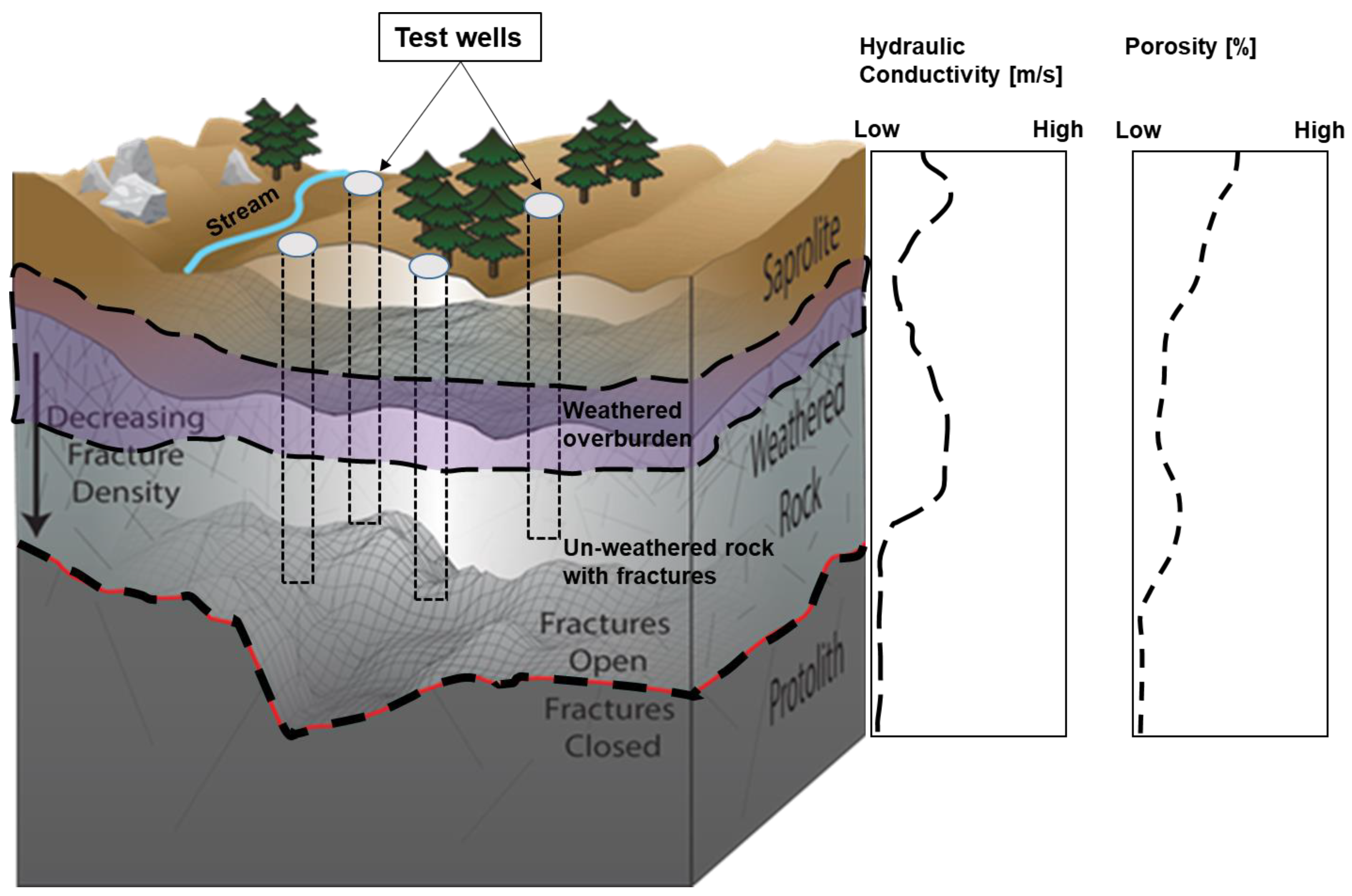
1.1. State of the Art
1.2. Research and Knowledge Gap in Nigeria
1.3. The Need for A Field Research Facility
2. The Ibadan Hydrogeophysics Research Site (IHRS)
2.1. Geologic Setting
2.2. Site Description
3. Materials and Methods
3.1. Electrical Resistivity Survey
3.2. Well Installation and Lithological Logs
3.3. Hydraulic Testing
4. Results
4.1. Lithological Logs and Hydraulic Tests
4.2. Electrical Resistivity
5. Discussion
5.1. Architecture and Heterogeneity of the Crystalline Basement Aquifer at IHRS
5.2. Hydraulic Properties of the Crystalline Basement Aquifer at IHRS
5.3. Expanding the IHRS and Further Research
6. Conclusions
Author Contributions
Funding
Data Availability Statement
Acknowledgments
Conflicts of Interest
References
- Chuma, C.; Hlatywayo, D.; Midzi, V.; Gumbo, M.; Muchingami, I. A comparison of crystalline basement aquifers and Kalahari aquifers in exploration of groundwater occurrence in Zimbabwe. In Proceedings of the Conference: RIE SET 2016, Bulawayo, Zimbabwe, 21–28 August 2016. [Google Scholar] [CrossRef]
- George, R.J. The nature and management of saprolite aquifers in the wheatbelt of western Australia. Land Degrad. Dev. 1990, 2, 261–275. [Google Scholar] [CrossRef]
- Lachassagne, P.; Wyns, R.; Dewandel, B. The fracture permeability of Hard Rock Aquifers is due neither to tectonics, nor to unloading, but to weathering processes. Terra Nova 2011, 23, 145–161. [Google Scholar] [CrossRef]
- Wright, E.P. The hydrogeology of crystalline basement aquifers in Africa. Geol. Soc. Lond. Spec. Publ. 1992, 66, 1–27. [Google Scholar] [CrossRef]
- Ofterdinger, U.; MacDonald, A.M.; Comte, J.C.; Young, M.E. Groundwater in fractured bedrock environments: Managing catchment and subsurface resources—An introduction. Geol. Soc. Lond. Spec. Publ. 2019, 479, 1. [Google Scholar] [CrossRef] [Green Version]
- Acworth, R. The development of crystalline basement aquifers in a tropical environment. Q. J. Eng. Geol. 1987, 20, 265–272. [Google Scholar] [CrossRef]
- Aizebeokhai, A.P.; Ogungbade, O.; Oyeyemi, K. Integrating VES and 2D ERI for near-surface characterization in a crystalline basement terrain. In SEG Technical Program Expanded Abstracts; Society of Exploration Geophysicists: Houston, TX, USA, 2018; pp. 5401–5406. [Google Scholar] [CrossRef]
- Maréchal, J.C.; Dewandel, B.; Subrahmanyam, K. Groundwater: Resource Evaluation, Augmentation, Contamination, Restoration, Modeling and Management; Thangarajan, M., Ed.; Springer: Dordrecht, The Netherlands, 2007; pp. 156–188. [Google Scholar]
- Adelana, S.M.A.; Olasehinde, P.I.; Balle, R.B.; Vrbka, P.; Edet, A.E.; Goni, I.B. An overview of the geology and hydrogeology of Nigeria. In Applied Groundwater Studies in Africa, Chapter: 11; Adelana, S.M.A., MacDonald, A.M., Eds.; Taylor & Francis: London, UK, 2008; pp. 171–197. [Google Scholar] [CrossRef]
- Ajayi, O.; Adegoke-Anthony, C.W. Groundwater prospects in the basement complex rocks of southwestern Nigeria. J. Afr. Earth Sci. 1988, 7, 227–235. [Google Scholar] [CrossRef]
- Chandra, S.; Auken, E.; Maurya, P.K.; Ahmed, S.; Verma, S.K. Large Scale Mapping of Fractures and Groundwater Pathways in Crystalline Hardrock By AEM. Sci. Rep. 2019, 9, 398. [Google Scholar] [CrossRef]
- Coleman, T.I.; Parker, B.L.; Maldaner, C.H.; Mondanos, M.J. Groundwater flow characterization in a fractured bedrock aquifer using active DTS tests in sealed boreholes. J. Hydrol. 2015, 528, 449–462. [Google Scholar] [CrossRef]
- Guihéneuf, N.; Boisson, A.; Bour, O.; Dewandel, B.; Perrin, J.; Dausse, A.; Viossanges, M.; Chandra, S.; Ahmed, S.; Maréchal, J.C. Groundwater flows in weathered crystalline rocks: Impact of piezometric variations and depth-dependent fracture connectivity. J. Hydrol. 2014, 511, 320–334. [Google Scholar] [CrossRef]
- Guiltinan, E.; Becker, M.W. Measuring well hydraulic connectivity in fractured bedrock using periodic slug tests. J. Hydrol. 2015, 521, 100–107. [Google Scholar] [CrossRef] [Green Version]
- Hazell, J.R.T.; Cratchley, C.R.; Jones, C.R.C. The hydrogeology of crystalline aquifers in northern Nigeria and geophysical techniques used in their exploration. Geol. Soc. Lond. Spec. Publ. 1992, 66, 155. [Google Scholar] [CrossRef]
- Doro, K.O.; Ehosioke, S.; Aizebeokhai, A.P. Sustainable Soil and Water Resources Management in Nigeria: The Need for a Data-Driven Policy Approach. Sustainability 2020, 12, 4204. [Google Scholar] [CrossRef]
- Edet, A. Hydrogeology and groundwater evaluation of a shallow coastal aquifer, southern Akwa Ibom State (Nigeria). Appl. Water Sci. 2017, 7, 2397–2412. [Google Scholar] [CrossRef] [Green Version]
- Eneh, O. Improving The Access To Potable Water In Nigeria. Afr. J. Sci. 2007, 8, 1962–1971. [Google Scholar]
- Flinchum, B.A.; Steven Holbrook, W.; Rempe, D.; Moon, S.; Riebe, C.S.; Carr, B.J.; Hayes, J.L.; St. Clair, J.; Peters, M.P. Critical zone structure under a granite ridge inferred from drilling and three-dimensional seismic refraction data. J. Geophys. Res. Earth Surf. 2018, 123, 1317–1343. [Google Scholar] [CrossRef]
- Doro, K.O.; Adegboyega, C.O.; Aizebeokhai, A.P.; Oladunjoye, M.A. Hydrological Variability in Crystalline Basement Aquifers—Insight from a First Hydrogeophysics Research Site in Nigeria. In Proceedings of the NSG2020 26th European Meeting of Environmental and Engineering Geophysics, Amsterdam, Netherlands, 7–8 December 2020; Volume 2020, pp. 1–5. [Google Scholar] [CrossRef]
- Aizebeokhai, A.P.; Oni, A.A.; Oyeyemi, K.D.; Ogungbade, O. Electrical resistivity imaging (ERI) data for characterising crystalline basement structures in Abeokuta, southwestern Nigeria. Data Brief 2018, 19, 2393–2397. [Google Scholar] [CrossRef]
- Badmus, B.S.; Olatinsu, O. Geophysical Characterization of Basement Rocks and Groundwater Potentials Using Electrical Sounding Data from Odeda Quarry Site, South-western. Nigeria. Asian J. Earth Sci. 2012, 5, 79–87. [Google Scholar] [CrossRef]
- Oladunjoye, M.; Jekayinfa, S. Efficacy of Hummel (Modified Schlumberger) Arrays of Vertical Electrical Sounding in Groundwater Exploration: Case Study of Parts of Ibadan Metropolis, Southwestern Nigeria. Int. J. Geophys. 2015, 2015, 612303. [Google Scholar] [CrossRef] [Green Version]
- Yakubu, I.; Mohamad Yusoff, I.; Rindam, M. Vertical Electrical Sounding Investigation of Aquifer Composition and Its Potential to Yield Groundwater in Some Selected Towns in Bida Basin of North Central Nigeria. J. Geogr. Geol. 2014, 6, 60. [Google Scholar] [CrossRef]
- Bayewu, O.O.; Oloruntola, M.O.; Mosuro, G.O.; Laniyan, T.A.; Ariyo, S.O.; Fatoba, J.O. Geophysical evaluation of groundwater potential in part of southwestern Basement Complex terrain of Nigeria. Appl. Water Sci. 2017, 7, 4615–4632. [Google Scholar] [CrossRef] [Green Version]
- Olayinka, A.I. Geophysical siting of boreholes in crystalline basement areas of Africa. J. Afr. Earth Sci. 1992, 14, 197–207. [Google Scholar] [CrossRef]
- Terhemba, B.; Obiora, D.; David, M.U.; Ezema, C.; Paul, O. Aquifers Characterization and Classification Using Electromagnetic and Galvanic Resistivity Methods in Basement Complex, Katsina-Ala, Central Nigeria. Int. J. Sci. Technoledge 2016, 4, 10–21. [Google Scholar]
- Alle, I.C.; Descloitres, M.; Vouillamoz, J.M.; Yalo, N.; Lawson, F.M.A.; Adihou, A.C. Why 1D electrical resistivity techniques can result in inaccurate siting of boreholes in hard rock aquifers and why electrical resistivity tomography must be preferred: The example of Benin, West Africa. J. Afr. Earth Sci. 2018, 139, 341–353. [Google Scholar] [CrossRef]
- Akinwumiju, A.S.; Olorunfemi, M.O. Modeling Groundwater Flow System of a Drainage Basin in the Basement Complex Environment of Southwestern Nigera. Proc. Int. Cartogr. Assoc. 2018, 1, 2. [Google Scholar] [CrossRef] [Green Version]
- Tijani, M.; Alichi, A.; Diop, S. Characterization Of Weathered Basement Aquifers: Implication For Groundwater Recharge. In Proceedings of the 7th International Symposium on Managed Aquifer Recharge (ISMAR-7), Madrid, Spain, 9–13 October 2010. [Google Scholar]
- Manoutsoglou, E.; Lazos, I.; Steiakakis, E.; Vafeidis, A. The Geomorphological and Geological Structure of the Samaria Gorge, Crete, Greece—Geological Models Comprehensive Review and the Link with the Geomorphological Evolution. Appl. Sci. 2022, 12, 10670. [Google Scholar] [CrossRef]
- Stober, I.; Bucher, K. Origin of salinity of deep groundwater in crystalline rocks. Terra Nov. 1999, 11, 181–185. [Google Scholar] [CrossRef]
- Banks, D.; Odling, N.E.; Skarphagen, H.; Rohr-Torp, E. Permeability and stress in crystalline rocks. Terra Nov. 1996, 8, 223–235. [Google Scholar] [CrossRef]
- Alazard, M.; Boisson, A.; Maréchal, J.-C.; Perrin, J.; Dewandel, B.; Schwarz, T.; Pettenati, M.; Picot-Colbeaux, G.; Kloppman, W.; Ahmed, S. Investigation of recharge dynamics and flow paths in a fractured crystalline aquifer in semi-arid India using borehole logs: Implications for managed aquifer recharge. Hydrogeol. J. 2016, 24, 35–57. [Google Scholar] [CrossRef]
- Steiakakis, E.; Monopolis, D.; Vavadakis, D.; Manutsoglu, E. Hydrogeological research in Trypali carbonate Unit (NW Crete). In Advances in the Research of Aquatic Environment; Springer: Berlin/Heidelberg, Germany, 2011; pp. 561–567. [Google Scholar] [CrossRef]
- Stober, I.; Bucher, K. Hydraulic properties of the crystalline basement. Hydrogeol. J. 2016, 15, 213–224. [Google Scholar] [CrossRef]
- Wanner, C.; Waber, H.N.; Bucher, K. Geochemical evidence for regional and long-term topography-driven groundwater flow in an orogenic crystalline basement (Aar Massif, Switzerland). J. Hydrol. 2020, 581, 124374. [Google Scholar] [CrossRef]
- Guihéneuf, N.; Bour, O.; Boisson, A.; Le Borgne, T.; Becker, M.W.; Nigon, B.; Wajiduddin, M.; Ahmed, S.; Maréchal, J.C. Insights about transport mechanisms and fracture flow channeling from multi-scale observations of tracer dispersion in shallow fractured crystalline rock. J. Contam. Hydrol. 2017, 206, 18–33. [Google Scholar] [CrossRef] [PubMed] [Green Version]
- Lachassagne, P.; Dewandel, B.; Wyns, R. Review: Hydrogeology of weathered crystalline/hard-rock aquifers—Guidelines for the operational survey and management of their groundwater resources. Hydrogeol. J. 2021, 29, 2561–2594. [Google Scholar] [CrossRef]
- Dewandel, B.; Lachassagne, P.; Zaidi, F.K.; Chandra, S. A conceptual hydrodynamic model of a geological discontinuity in hard rock aquifers: Example of a quartz reef in granitic terrain in South India. J. Hydrol. 2011, 405, 474–487. [Google Scholar] [CrossRef] [Green Version]
- Boisson, A.; Guihéneuf, N.; Perrin, J.; Bour, O.; Dewandel, B.; Amélie, D.; Viossanges, M.; Ahmed, S.; Maréchal, J.-C. Determining the vertical evolution of hydrodynamic parameters in weathered and fractured south Indian crystalline-rock aquifers: Insights from a study on an instrumented site. Hydrogeol. J. 2015, 23, 757–773. [Google Scholar] [CrossRef]
- Dewandel, B.; Lachassagne, P.; Wyns, R.; Maréchal, J.C.; Krishnamurthy, N.S. A generalized 3-D geological and hydrogeological conceptual model of granite aquifers controlled by single or multiphase weathering. J. Hydrol. 2006, 330, 260–284. [Google Scholar] [CrossRef]
- Neuman, S.P. Trends, prospects and challenges in quantifying flow and transport through fractured rocks. Hydrogeol. J. 2005, 13, 124–147. [Google Scholar] [CrossRef]
- Yidana, S.M.; Fynn, O.F.; Chegbeleh, L.P.; Nude, P.M.; Asiedu, D.K. Hydrogeological Conditions of a Crystalline Aquifer: Simulation of Optimal Abstraction Rates under Scenarios of Reduced Recharge. Sci. World J. 2013, 2013, 606375. [Google Scholar] [CrossRef]
- Boutt, D.F.; Diggins, P.; Mabee, S. A field study (Massachusetts, USA) of the factors controlling the depth of groundwater flow systems in crystalline fractured-rock terrain. Hydrogeol. J. 2010, 18, 1839–1854. [Google Scholar] [CrossRef]
- St. Clair, J.; Moon, S.; Holbrook, W.S.; Perron, J.T.; Riebe, C.S.; Martel, S.J.; Carr, B.; Harman, C.; Singha, K.; Richter, D.D. Geophysical imaging reveals topographic stress control of bedrock weathering. Science 2015, 350, 534. [Google Scholar] [CrossRef] [Green Version]
- Doro, K.O.; Leven, C.; Cirpka, O.A. Delineating subsurface heterogeneity at a loop of River Steinlach using geophysical and hydrogeological methods. Environ. Earth Sci. 2013, 69, 335–348. [Google Scholar] [CrossRef]
- De Carlo, L.; Caputo, M.C.; Masciale, R.; Vurro, M.; Portoghese, I. Monitoring the Drainage Efficiency of Infiltration Trenches in Fractured and Karstified Limestone via Time-Lapse Hydrogeophysical Approach. Water 2020, 12, 2009. [Google Scholar] [CrossRef]
- Doro, K.O. Developing Tracer Tomography as a Field Technique for Aquifer Characterization. Ph.D. Thesis, Eberhard-Karls-Universität Tübingen, Tübingen, Germany, 2015. [Google Scholar]
- Barker, J. A generalized radial flow model for pumping tests in fractured rock. Water Resource Res. 1988, 24, 1796–1804. [Google Scholar] [CrossRef] [Green Version]
- Becker, M.; Shapiro, A. Interpreting tracer breakthrough tailing from different forced-gradient tracer experiment configurations in fractured bedrock. Water Resour Res. 2003, 39, 1024. [Google Scholar] [CrossRef] [Green Version]
- Amadi, A.N.; Olasehinde, P.I. Application of remote sensing techniques in hydrogeological mapping of parts of Bosso area, Minna, North-Central Nigeria. Int. J. Phys. Sci. 2010, 5, 1465–1474. [Google Scholar]
- Badamasi, S.; Sawa, B.A.; Garba, M.L. Groundwater Potential Zones Mapping Using Remote Sensing and Geographic Information System Techniques (GIS) in Zaria, Kaduna State, Nigeria. Am. Acad. Sci. Res. J. Eng. Technol. Sci. 2016, 24, 51–62. [Google Scholar]
- Fashae, O.A.; Tijani, M.N.; Talabi, A.O.; Adedeji, O.I. Delineation of groundwater potential zones in the crystalline basement terrain of SW-Nigeria: An integrated GIS and remote sensing approach. Appl. Water Sci. 2014, 4, 19–38. [Google Scholar] [CrossRef] [Green Version]
- Oyedele, A.A. Use of remote sensing and GIS techniques for groundwater exploration in the basement complex terrain of Ado-Ekiti, SW Nigeria. Appl. Water Sci. 2019, 9, 51. [Google Scholar] [CrossRef] [Green Version]
- Bayewu, O.O.; Oloruntola, M.O.; Mosuro, G.O.; Laniyan, T.A.; Ariyo, S.O.; Fatoba, J.O. Assessment of groundwater prospect and aquifer protective capacity using resistivity method in Olabisi Onabanjo University campus, Ago-Iwoye, Southwestern Nigeria. NRIAG J. Astron. Geophys. 2018, 7, 347–360. [Google Scholar] [CrossRef]
- Adepelumi, A.A.; Yi, M.J.; Kim, J.H.; Ako, B.D.; Son, J.S. Integration of surface geophysical methods for fracture detection in crystalline bedrocks of southwestern Nigeria. Hydrogeol. J. 2006, 14, 1284–1306. [Google Scholar] [CrossRef]
- Bayewu, O.O.; Oloruntola, M.O.; Mosuro, G.O.; Laniyan, T.A.; Fatoba, J.O.; Folorunso, I.O.; Kolawole, A.U.; Bada, B.T. Application of cross-square array and resistivity anisotropy for fracture detection in crystalline bedrock. Arab. J. Geosci. 2016, 9, 291. [Google Scholar] [CrossRef]
- Osumeje, J.O.; Kudamnya, E.A. Hydrogeophysical Investigation Using Seismic Refraction Tomography to Study the Groundwater Potential of Ahmadu Bello University Main Campus, within the Basement Complex of Northern Nigeria. J. Environ. Earth Sci. 2014, 4, 15–22. [Google Scholar]
- Falowo, O.O.; Daramola, A.S.; Ojo, O.O. Aquifer hydraulic parameter measurement and analysis by pumping test. Am. J. Water Resour. 2019, 7, 146–154. [Google Scholar] [CrossRef]
- Kwada, J.; Adekeye, J.I.D. Hydrogeological Characterization And Water Supply Potential Of Basement Aquifers In Taraba State, N.E. Nigeria. Nat. Sci. 2009, 7, 75–83. [Google Scholar]
- Abimiku, E.S.; Dadan-Garba, A.; Adepetu, A.A. Determination of groundwater potentials in crystalline basement areas of Bauchi Local Government Area, Bauchi. J. Environ. Earth Sci. 2019, 9, 6–10. [Google Scholar] [CrossRef]
- Sule, B.F.; Balogun, O.S.; Muraina, L.B. Determination of hydraulic characteristics of groundwater aquifer in Ilorin, North Central Nigeria. Sci. Res. Essays 2013, 18, 1150–1161. [Google Scholar] [CrossRef]
- Akintorinwa, O.J.; Atitebi, M.O.; Akinlalu, A.A. Hydrogeophysical and aquifer vulnerability zonation of a typical basement complex terrain: A case study of Odode Idanre southwestern Nigeria. Heliyon 2020, 6, e04549. [Google Scholar] [CrossRef]
- Adabanija, M.A.; Ajibade, R.A. Investigating groundwater corrosion and overburden protective capacity in a low latitude crystalline basement complex of southwestern Nigeria. NRIAG J. Astron. Geophys. 2020, 9, 245–259. [Google Scholar] [CrossRef] [Green Version]
- Adewunmi, A.J.; Anifowose, A.Y.B.; Olabode, F.O.; Laniyan, T.A. Hydrogeochemical characterization and vulnerability assessment of shallow groundwater in basement complex area, Southwest Nigeria. Contemp. Trends Geosci. 2018, 7, 72–103. [Google Scholar] [CrossRef]
- Talabi, A.O.; Tijani, M.N. Hydrochemical and stable isotopic characterization of shallow groundwater system in the crystalline basement terrain of Ekiti area, southwestern Nigeria. Appl. Water Sci. 2013, 3, 229–245. [Google Scholar] [CrossRef] [Green Version]
- Edet, A.; Abdelaziz, R.; Merkel, B.; Okereke, C.; Nganje, T. Numerical Groundwater Flow Modeling of the Coastal Plain Sand Aquifer, Akwa Ibom State, SE Nigeria. J. Water Resour. Prot. 2014, 06, 193–201. [Google Scholar] [CrossRef] [Green Version]
- Igboekwe, M.U.; Rao, G.V.V.S.; Okueze, E.E. Groundwater flow modeling of Kwa Ibo river watershed, Southeastern Nigeria. Glob. J. Geol. Sci. 2005, 3, 169–177. [Google Scholar] [CrossRef]
- Barrash, W.; Knoll, M. Design of research wellfield for calibrating geophysical methods against hydrologic parameter. In Proceedings of the 1998 Conference on Hazardous Waste Research, Snowbird, UT, USA, 19–21 May 1988; pp. 296–318. [Google Scholar]
- Riva, M.; Guadagnini, A.; Fernandez-Garcia, D.; Sanchez-Vila, X.; Ptak, T. Relative importance of geostatistical and transport models in describing heavily tailed breakthrough curves at the Lauswiesen site. J. Contam. Hydrol. 2008, 101, 1–13. [Google Scholar] [CrossRef] [PubMed]
- Cirpka, O.A.; Leven, C.; Schwede, R.; Doro, K.O.; Bastian, P.; Ippisch, O.; Klein, O.; Patzelt, A. Tomographic Methods in Hydrogeology. In Tomography of the Earth’s Crust: From Geophysical Sounding to Real-Time Monitoring; Springer: Cham, Switzerland, 2014; pp. 157–176. [Google Scholar]
- Maréchal, J.-C.; Selles, A.; Dewandel, B.; Boisson, A.; Perrin, J.; Ahmed, S. An Observatory of Groundwater in Crystalline Rock Aquifers Exposed to a Changing Environment: Hyderabad, India. Vadose Zone J. 2018, 17, 180076. [Google Scholar] [CrossRef] [Green Version]
- Séguis, L.; Kamagaté, B.; Favreau, G.; Descloitres, M.; Seidel, J.L.; Galle, S.; Peugeot, C.; Gosset, M.; Le Barbé, L.; Malinur, F.; et al. Origins of streamflow in a crystalline basement catchment in a sub-humid Sudanian zone: The Donga basin (Benin, West Africa): Inter-annual variability of water budget. J. Hydrol. 2011, 402, 1–13. [Google Scholar] [CrossRef]
- Fovet, O.; Ruiz, L.; Gruau, G.; Akkal, N.; Aquilina, L.; Busnot, S.; Dupas, R.; Durand, P.; Faucheux, M.; Fauvel, Y.; et al. AgrHyS: An Observatory of Response Times in Agro-Hydro Systems. Vadose Zone J. 2018, 17, 180066. [Google Scholar] [CrossRef] [Green Version]
- Caby, R. Precambrian terranes of Benin-Nigeria and northeast Brazil and the Late Proterozoic south Atlantic fit. In Terranes in the Circum-Atlantic Paleozoic Orogens; Dallmeyer, R.D., Ed.; The Geological Society of America, Inc.: Boulder, CO, USA, 1989; pp. 145–158. [Google Scholar] [CrossRef]
- Rahaman, M.A. Geology of Nigeria; Kogbe, C., Ed.; Elizabethan Publishers: Lagos, Nigeria, 1976; pp. 41–58. [Google Scholar]
- Rahaman, M.A. Recent Advances in the Study of the Basement Complex of Nigeria; Ward, S.H., Ed.; Geological Survey of Nigeria: Kaduna, Nigeria, 1988; pp. 11–41.
- Elueze, A.A. Geology of the Precambrian Schist Belt in Ilesha Area, Southwestern Niveria; Ward, S.H., Ed.; Geological Survey of Nigeria: Kaduna, Nigeria, 1988; pp. 77–82.
- Grant, N.K. Geochronology of Precambrian basement rocks from Ibadan, Southwestern Nigeria. Earth Planet. Sci. Lett. 1970, 10, 29–38. [Google Scholar] [CrossRef]
- Oyawoye, M.O. African Geology; Dessauvagie, T.F.J., Whiteman, A.J., Eds.; University of Ibadan Press: Ibadan, Nigeria, 1970; pp. 67–99. [Google Scholar]
- Odjugo, P. An analysis of rainfall patterns in Nigeria. Glob. J. Environ. Sci. 2006, 4, 139–145. [Google Scholar] [CrossRef] [Green Version]
- Blanchy, G.; Saneiyan, S.; Boyd, J.; McLachlan, P.; Binley, A. ResIPy, an intuitive open source software for complex geoelectrical inversion/modeling. Comput. Geosci. 2020, 137, 104423. [Google Scholar] [CrossRef]
- Doro, K.O.; Emmanuel, E.D.; Adebayo, M.B.; Bank, C.G.; Wescott, D.J.; Mickleburgh, H.L. Time-lapse electrical resistivity tomography imaging of buried human remains in simulated mass and individual graves. Front. Environ. Sci. 2022, 10, 882496. [Google Scholar] [CrossRef]
- Binley, A.; Andreas, K. DC resistivity and induced polarization methods. In Hydrogeophysics; Springer: Dordrecht, The Netherland, 2005; pp. 129–156. [Google Scholar]
- Binley, A.; Lee, S. Resistivity and Induced Polarization: Theory and Applications to the Near-Surface Earth; Cambridge University Press: Cambridge, UK, 2020. [Google Scholar]
- Constable, S.C.; Parker, R.L.; Constable, C.G. Occam’s inversion: A practical algorithm for generating smooth models from electromagnetic sounding data. GEOPHYSICS 1987, 52, 289–300. [Google Scholar] [CrossRef]
- Barker, J.A. Generalized well function evaluation for homogeneous and fissured aquifers. J. Hydrol. 1985, 76, 143–154. [Google Scholar] [CrossRef]
- De Smedt, F. Analytical Solution for Fractional Well Flow in a Double-Porosity Aquifer with Fractional Transient Exchange between Matrix and Fractures. Water 2022, 14, 456. [Google Scholar] [CrossRef]
- Kruseman, G.P.; De Ridder, N.A.; Verweij, J.M. Analysis and Evaluation of Pumping Test Data; International Institute for Land Reclamation and Improvement: Wageningen, The Netherlands, 1970; Volume 11, p. 200. [Google Scholar]
- Earle, S. Physical Geology, BCcampus, Victoria, British Columbia, Canada 2019. Available online: https://opentextbc.ca/physicalgeology2ed/ (accessed on 18 December 2022).
- Akurugu, B.A.; Chegbeleh, L.P.; Yidana, S.M. Characterisation of groundwater flow and recharge in crystalline basement rocks in the Talensi District, Northern Ghana. J. Afr. Earth Sci. 2020, 161, 103665. [Google Scholar] [CrossRef]
- Taylor, R. Weathered rock aquifers: Vital but poorly developed. Waterlines 2001, 20, 3–6. [Google Scholar] [CrossRef]
- Loke, M.H.; Acworth, I.; Dahlin, T. A comparison of smooth and blocky inversion methods in 2D electrical imaging surveys. Explor. Geophys. 2003, 34, 182–187. [Google Scholar] [CrossRef]
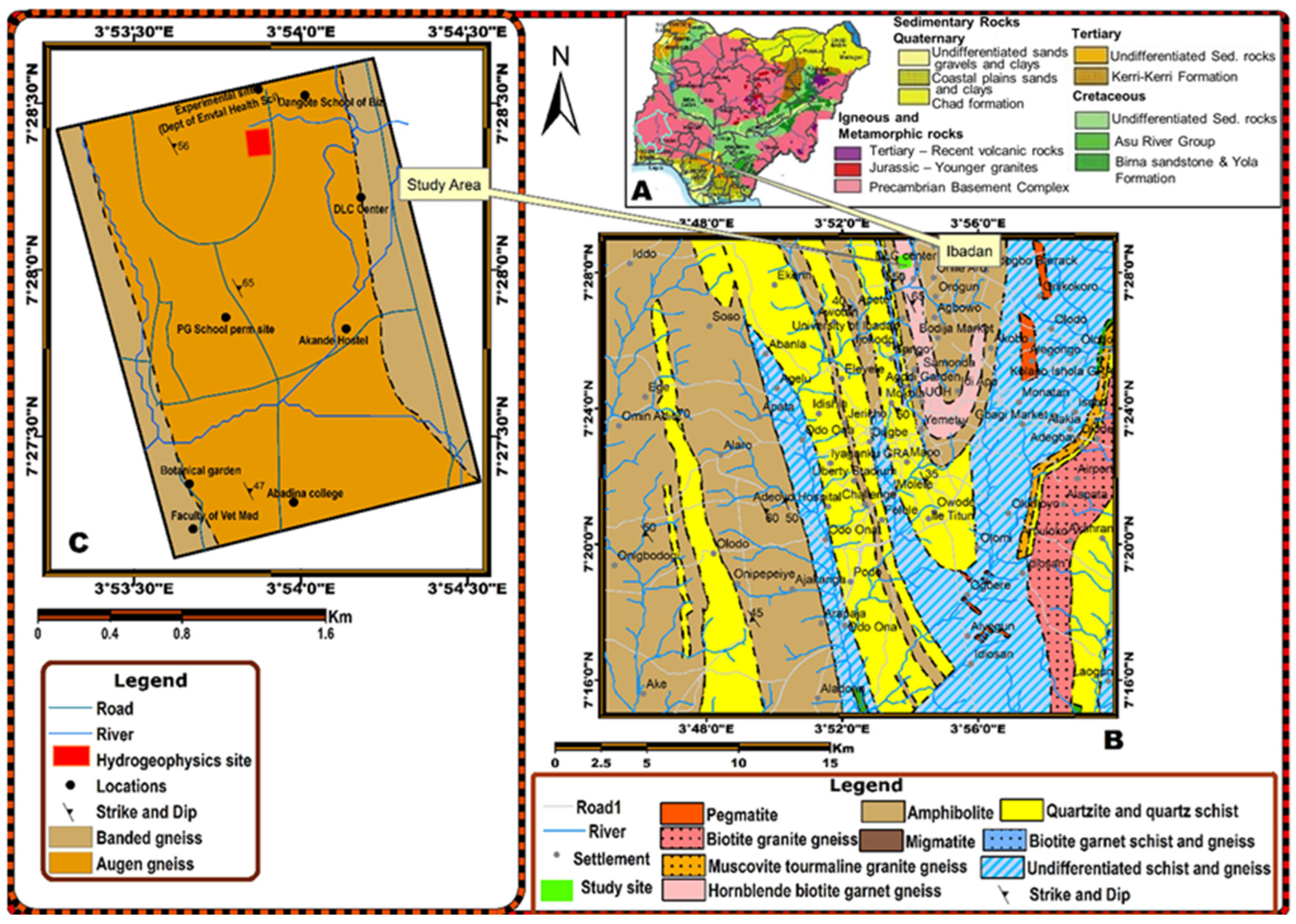
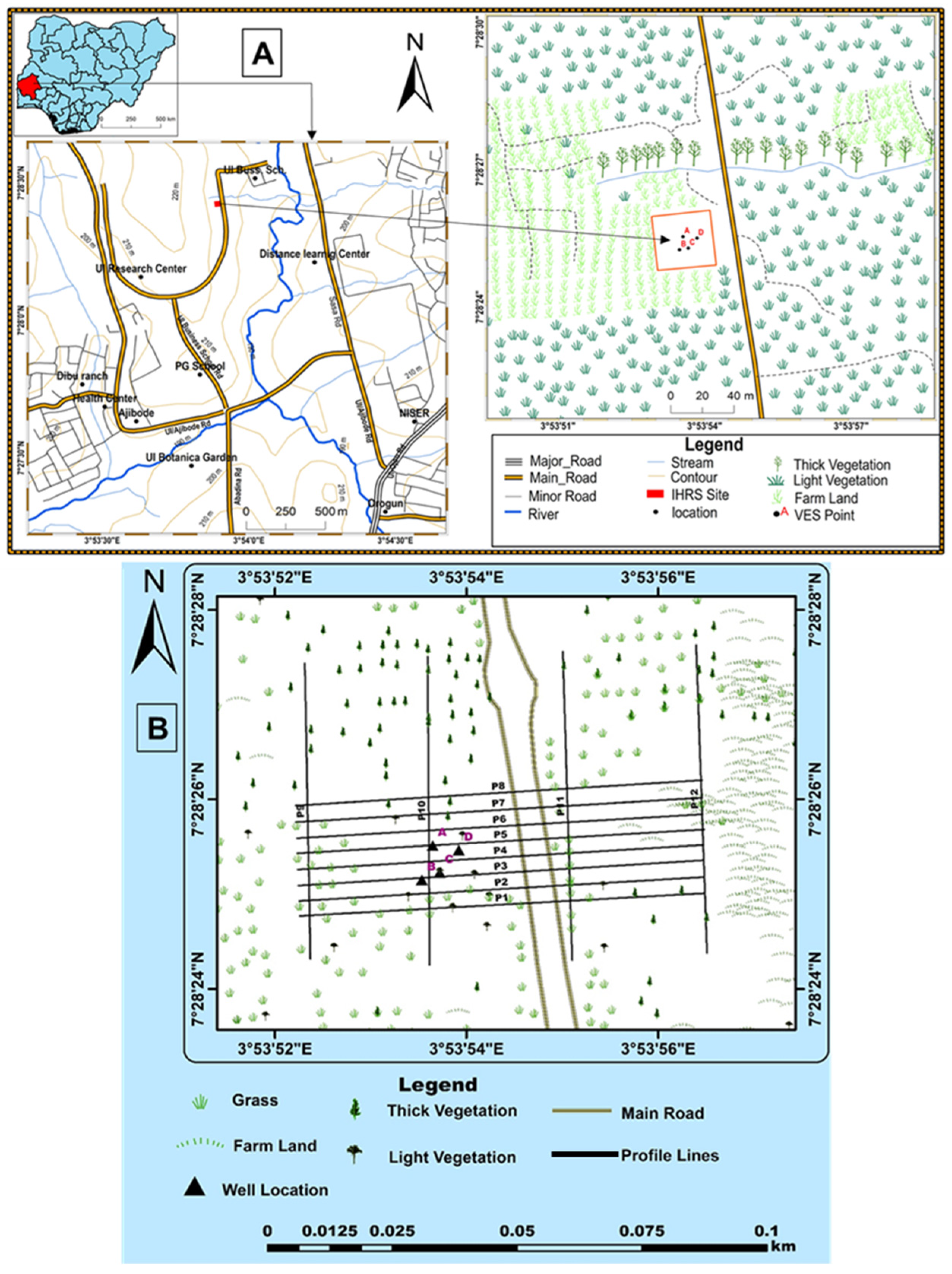





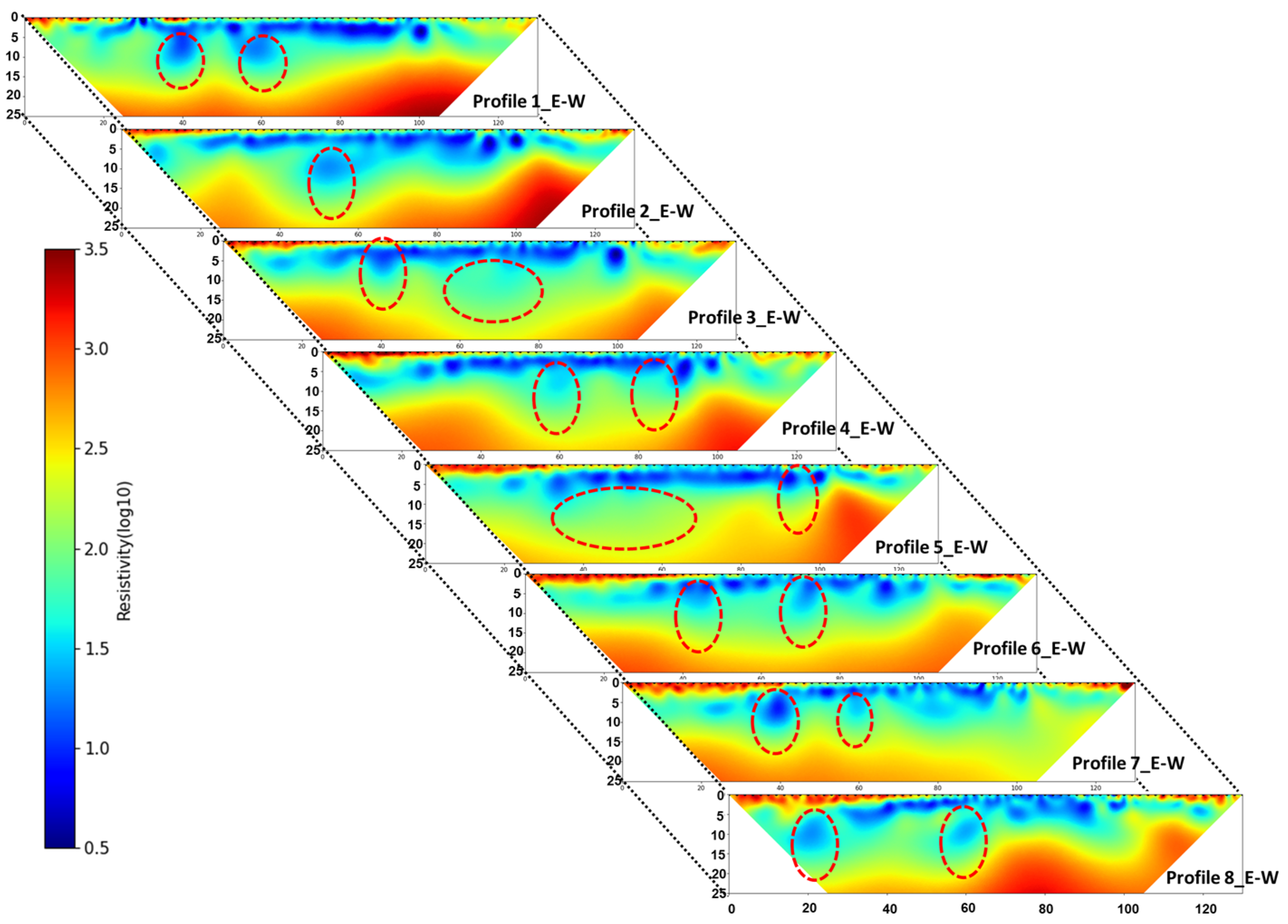

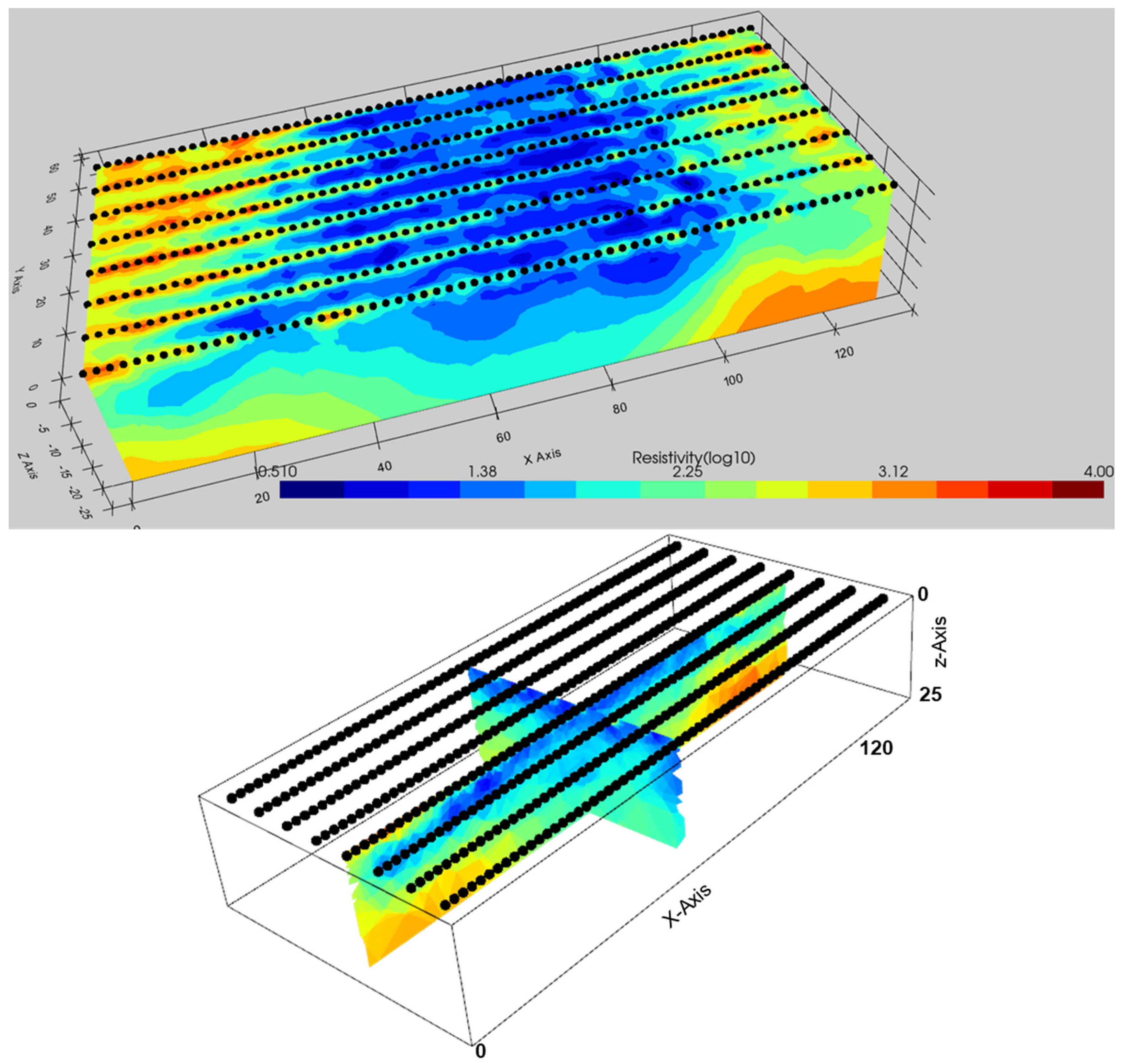
| VES Station | Layers | ρ (Ωm) | h (m) | d (m) | Lithology |
|---|---|---|---|---|---|
| 1 | 1 | 41 | 0.6 | 0.6 | Topsoil |
| 2 | 27 | 9.3 | 9.9 | Weathered layer | |
| 3 | 847 | - | - | Fractured basement | |
| 2 | 1 | 573 | 0.9 | 0.9 | Topsoil |
| 2 | 17 | 5.2 | 6.1 | Weathered layer | |
| 3 | 444 | 13.4 | 19.5 | Weathered/fractured basement | |
| 4 | 1302 | - | - | Fresh basement | |
| 3 | 1 | 480 | 0.5 | 0.5 | Topsoil |
| 2 | 83 | 0.9 | 1.4 | Weathered layer | |
| 3 | 13 | 4.8 | 6.3 | Weathered/fractured basement | |
| 4 | 1344 | - | - | Fresh basement | |
| 4 | 1 | 162 | 1.3 | 1.3 | Topsoil |
| 2 | 14 | 6.3 | 7.6 | Weathered layer | |
| 3 | 467 | 11.1 | 18.7 | Weathered/fractured basement | |
| 4 | 1073 | - | - | Fresh basement | |
| 5 | 1 | 153 | 0.8 | 0.8 | Topsoil |
| 2 | 23 | 7.5 | 8.3 | Weathered layer | |
| 3 | 402 | 13.1 | 22 | Weathered/fractured basement | |
| 4 | 1279 | - | - | Fresh basement | |
| 6 | 1 | 79 | 1.2 | 1.2 | Topsoil |
| 2 | 12 | 4.2 | 5.5 | Weathered layer | |
| 3 | 465 | 15.7 | 21.2 | Weathered/fractured basement | |
| 4 | 1554 | - | - | Fresh basement |
Disclaimer/Publisher’s Note: The statements, opinions and data contained in all publications are solely those of the individual author(s) and contributor(s) and not of MDPI and/or the editor(s). MDPI and/or the editor(s) disclaim responsibility for any injury to people or property resulting from any ideas, methods, instructions or products referred to in the content. |
© 2023 by the authors. Licensee MDPI, Basel, Switzerland. This article is an open access article distributed under the terms and conditions of the Creative Commons Attribution (CC BY) license (https://creativecommons.org/licenses/by/4.0/).
Share and Cite
Doro, K.O.; Adegboyega, C.O.; Aizebeokhai, A.P.; Oladunjoye, M.A. The Ibadan Hydrogeophysics Research Site (IHRS)—An Observatory for Studying Hydrological Heterogeneities in A Crystalline Basement Aquifer in Southwestern Nigeria. Water 2023, 15, 433. https://doi.org/10.3390/w15030433
Doro KO, Adegboyega CO, Aizebeokhai AP, Oladunjoye MA. The Ibadan Hydrogeophysics Research Site (IHRS)—An Observatory for Studying Hydrological Heterogeneities in A Crystalline Basement Aquifer in Southwestern Nigeria. Water. 2023; 15(3):433. https://doi.org/10.3390/w15030433
Chicago/Turabian StyleDoro, Kennedy O., Christianah O. Adegboyega, Ahzegbobor P. Aizebeokhai, and Michael A. Oladunjoye. 2023. "The Ibadan Hydrogeophysics Research Site (IHRS)—An Observatory for Studying Hydrological Heterogeneities in A Crystalline Basement Aquifer in Southwestern Nigeria" Water 15, no. 3: 433. https://doi.org/10.3390/w15030433






